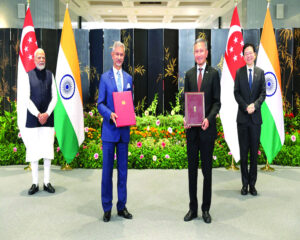Mappls : India’s Indigenous Navigation Revolution Developed by Indian Company MapmyIndia
G7 Summit 2025 : Key Takeaways from Kananaskis

G7 Summit 2025
The 51st G7 Summit was held on June 16–17, 2025, in Kananaskis, Alberta, Canada, where leaders from Canada, France, Germany, Italy, Japan, the United Kingdom, and the United States came together for high-level discussions. Representatives from the European Union and invited guests. Against a backdrop of global conflicts and economic challenges, the summit aimed to address pressing issues like the Russia-Ukraine war, Middle East tensions, trade policies, and energy security. However, the event was marked by unexpected disruptions and mixed outcomes. Below are the key takeaways from this pivotal gathering.
U.S. President Trump’s Abrupt Exit
One of the summit’s defining moments was U.S. President Donald Trump’s early departure on June 16 to address escalating tensions in the Israel-Iran conflict. This move disrupted a planned meeting with Ukrainian President Volodymyr Zelenskyy, derailing efforts to secure U.S. support for pressuring Russia into a Ukraine ceasefire. Trump’s focus shifted to the Middle East, with speculation about potential U.S. involvement in Israeli strikes against Iran’s nuclear facilities. His absence left a void in discussions, raising questions about the G7’s ability to align on critical global issues and fueling debates about the group’s relevance in a shifting geopolitical landscape.

Ukraine and Russia: A Fractured G7 Response
The Russia-Ukraine war was a central focus, but divisions emerged, particularly after Trump’s exit. His expressed support for Russian President Vladimir Putin complicated efforts to craft a unified G7 stance. Canada, as host, had hoped to issue a strong statement condemning Russia and supporting Ukraine but scrapped these plans due to U.S. resistance. Ukrainian President Zelenskyy called the diplomatic situation a “crisis,” urging G7 leaders to leverage their influence to end the conflict.
Despite the setbacks, Canada stepped up with significant commitments, announcing $4.3 billion in aid for Ukraine. This package included $2 billion in military support—comprising helicopters, drones, and ammunition—and $2.3 billion in loans for infrastructure rebuilding. Canada also condemned Russia’s recent deadly attack on Kyiv, labeling it an act of “barbarism.” Other G7 members reaffirmed their support for Ukraine, but the lack of U.S. alignment underscored the challenges of coordinated action.
Middle East Tensions Take Center Stage
The Israel-Iran conflict loomed large over the summit, with G7 leaders issuing a joint statement condemning Iran as a source of regional instability and emphasizing that Iran must not acquire nuclear weapons. Trump’s early departure was directly tied to these tensions, with reports indicating U.S. preparations for potential military engagement alongside Israel. The G7’s unified stance on Iran contrasted with its divisions over Ukraine, highlighting the complex balancing act of addressing multiple global crises simultaneously.
India’s Role and Diplomatic Efforts
Indian Prime Minister Narendra Modi’s attendance—his sixth consecutive G7 summit—underscored India’s growing global influence. Modi emphasized energy security, green technology pathways, and the need for collective action against terrorism. His presence also sparked protests from Sikh groups over Canada’s allegations regarding the 2023 killing of Hardeep Singh Nijjar, a Canadian Sikh leader. Despite these tensions, Modi held productive meetings with Canadian Prime Minister Mark Carney and other leaders to reset India-Canada relations and explore trade opportunities, including a proposed Europe-Middle East-India trade corridor.

Trade, Tariffs, and Economic Cooperation
Trade discussions yielded mixed results. Trump secured a framework for a new trade deal with the United Kingdom but criticized the European Union and Japan for what he called unfair trade practices, singling out Japan as “tough” in negotiations. Canada, meanwhile, made progress on a potential U.S. trade agreement and brokered initiatives for critical minerals stockpiling and cross-border wildfire coordination. These efforts reflect the G7’s ongoing focus on economic resilience amid global uncertainties.
Global South and Energy Security
South African President Cyril Ramaphosa, the only African leader invited, advocated for the Global South’s priorities, calling for a fairer global order. Modi echoed this sentiment, highlighting sustainable energy solutions to support AI-driven and technology-intensive societies. The G7’s discussions on energy security underscored the need for collaborative approaches to address climate challenges while ensuring economic stability.
Indigenous Engagement
In a notable moment, Indigenous leader Steven Crowchild of the Tsuut’ina First Nation welcomed G7 leaders, including Trump, to the summit. Crowchild described the encounter with Trump as “intense” but emphasized the importance of Indigenous voices in global dialogues. This gesture highlighted Canada’s commitment to incorporating Indigenous perspectives into international forums.

Questions About the G7’s Future
Trump’s early exit and his “America First” approach prompted renewed scrutiny of the G7’s effectiveness. Critics, including Russian official Maksim Oreshkin, argued that the G7 no longer drives global economic growth, pointing to the G20 as a more inclusive platform. Despite these challenges, Canadian Prime Minister Mark Carney earned praise for his deft handling of a complex summit, navigating diplomatic tensions and securing tangible outcomes like aid for Ukraine and trade progress.
Also Read This : Mahindra XUV700 Facelift: What to Expect from the Upcoming XUV 7XO
The 51st G7 Summit in Kananaskis was a microcosm of today’s fractured global landscape. While it achieved progress in areas like critical minerals, trade frameworks, and support for Ukraine, it also exposed deep divisions, particularly over Russia and the U.S.’s role in global diplomacy. The summit underscored the urgency of addressing conflicts in Ukraine and the Middle East, the importance of inclusive partnerships with the Global South, and the need for the G7 to adapt to a rapidly evolving world. As the international community looks ahead, the outcomes of Kananaskis 2025 will shape diplomatic and economic strategies for years to come.


